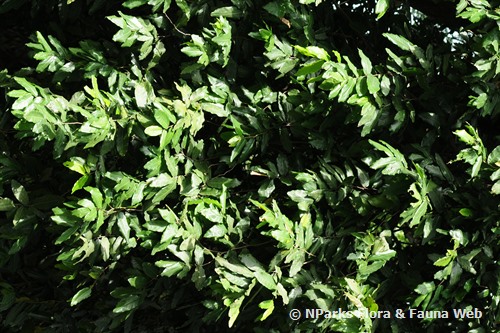
Back
Inocarpus fagifer
| Family Name: | Fabaceae (Leguminosae) |
| Synonyms: | Inocarpus edulis, Inocarpus fagiferus |
| Common Name: | Tahiti Chestnut |
Name
Classifications and Characteristics
| Plant Division | Angiosperms (Flowering Seed Plants) |
|---|---|
| Plant Growth Form | Tree |
| Maximum Height | 30 m |
Biogeography
| Native Distribution | Likely from eastern Malesia. |
|---|---|
| Native Habitat | Terrestrial |
| Preferred Climate Zone | Tropical |
Description and Ethnobotany
| Growth Form | It is a tree, up to 30 m tall and often producing several stems. Buttresses can grow up to 3 m long if present. Bark is dark brown, slightly flaky and inner bark have red sap. |
|---|---|
| Foliage | Leaves are oblong to ovate (10 – 50 cm long and 4 – 18 cm wide), in alternate arrangement and appears drooping. Leaves are pink when young and becoming shiny yellowish – green as it mature. Petiole is 0.5 – 1.5 cm long and stipule is small. |
| Flowers | Inflorescence is 1 – 17 cm long and occurs in the axillary position. Flowers are very fragrant and small, comprising of 5 creamish white recurved petals, and 10 stamens in two series. Calyx is tubular and has 2 – 5 teeth. |
| Fruit | Seed pod shape is variable, usually about 5 – 10 cm long and 5 – 8 cm wide, 1-seeded and does not split open. Seed pod is green and ripens orange-brown. Seed is about 8 cm long. |
| Habitat | It is found in swamp forest or near rivers, stream and even brackish water. |
| Cultivation | It can tolerate shade and waterlogged conditions. Fruit takes about 4 months to ripen and seed can germinate within 7 days after sowing. It can be propagated by stem cuttings and coppice. Seed rapidly changes from white to reddish brown after removal from the shell, and loses its viability. Seed is likely dispersed by water, and can float in seawater for over one month, but quickly loses its viability. |
| Etymology | Greek inos, fibre; Greek karpos, fruit, referring to the character of the fruit. Latin fagus, beech tree like; Latin ferre, to bear. |
| Ethnobotanical Uses | Edible Plant Parts : Edible Fruits Food (Fruit or Vegetable) Cultural / Religious: Heritage Tree : There is currently one individual of Inocarpus fagifer listed as a Heritage Tree in Singapore. It can be found in the Singapore Botanic Gardens. To find out more about this tree, please visit the Heritage Tree Register. Others: It is a shade providing tree where its wood can be used to make furniture, craving and firewood. In Solomon Island, large leaves are sown together to make sails and wrapping food. Ripe seeds can be eaten after boiling or roasting, and taste like chestnut. In Borneo and Java, tannin from the bark is consume as a remedy against intestinal disorders. In Solomon Island, the bark is grated and mixed with coconut milk or bark sap to treat urinary infections. |
Fauna, Pollination and Dispersal
| Seed or Spore Dispersal | Abiotic |
|---|
Plant Care and Propagation
| Light Preference | Full Sun, Semi-Shade |
|---|---|
| Water Preference | Moderate Water |
| Plant Growth Rate | Moderate |
| Propagation Method | Seed, Stem Cutting |
Foliar
| Mature Foliage Colour(s) | Green |
|---|
References
| References | Janick, J. & Paull, R.E. 2008. The Encyclopedia of Fruit and Nuts. CABI. 954 Whitmore, T.C. 1972. Tree Flora of Malaya Vol 1. Hong Kong : Wing Tai Cheung Printing Co Ltd. 469 |
|---|
Image Repository
Others
| Master ID | 30018 |
|---|---|
| Species ID | 4327 |
| Flora Disclaimer | The information in this website has been compiled from reliable sources, such as reference works on medicinal plants. It is not a substitute for medical advice or treatment and NParks does not purport to provide any medical advice. Readers should always consult his/her physician before using or consuming a plant for medicinal purposes. |



